It’s estimated that there are over 5 billion mobile devices worldwide,1 2.7 billion of those being smart phones.2 In studies, the average American checks their phone every 12 minutes, and opens apps 11+ times per day.3 Ninety percent of mobile time is spent in applications!4
To make the best business use of these statistics, you need to start at square one: choosing the most suitable mobile app development path to create an app that will reach your target users and supply the UX they demand.
While various mobile dev camps argue about which approach is better, the reality is that businesses simply need mobile applications that work for their customers, employees, and business partners. In this article, we’ll discuss three different kinds of mobile app development, their pros and cons, and which Softjourn recommends.
Understanding Your Audience
Knowing where your audience is, what devices they use, and what OS they prefer can tell you what mobile app development process to choose. Once you have an application ready for download in either the Apple App Store or Google Play Store, you want users to download it. That means taking a few areas into consideration.
Free vs. Paid
There isn’t one right way to monetize an application. However, most downloaded applications are free: 98% of the apps that make it onto phones are considered “freemium.”5
Even though users that pay for apps are in the minority, they typically have a higher engagement rate. They’re not just going to download the app and then delete it a few days later.
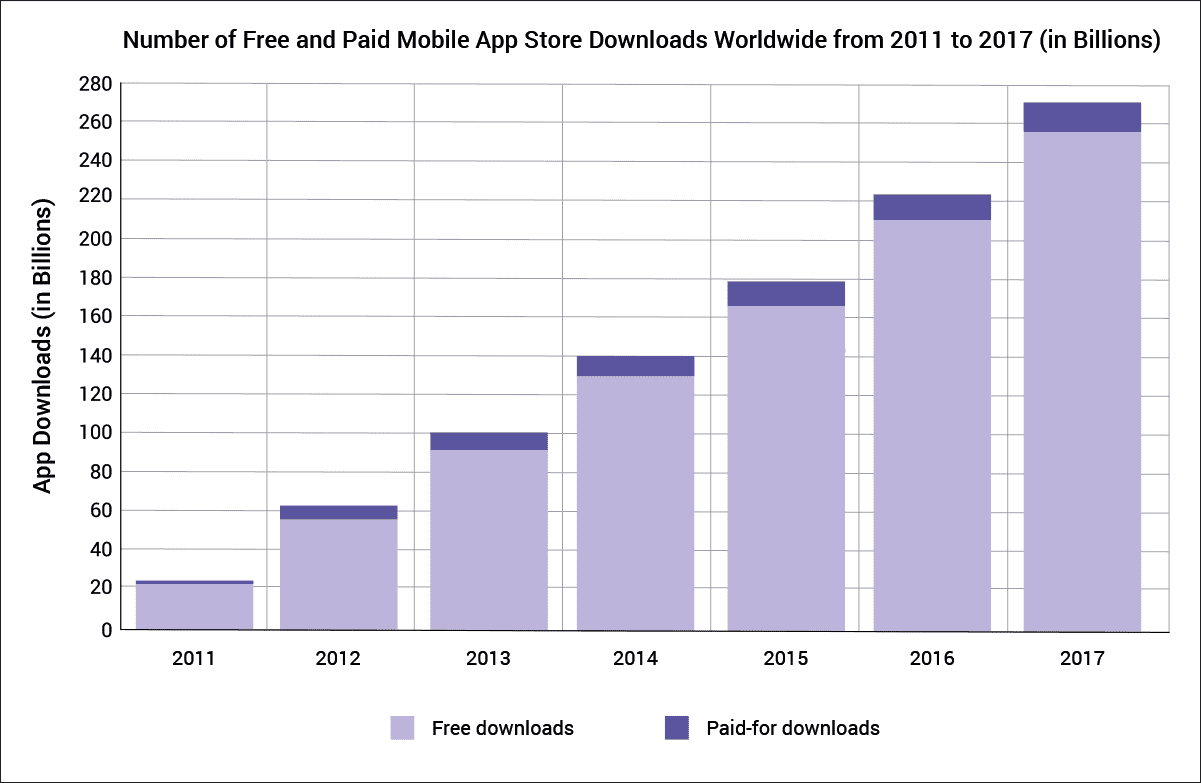
And this doesn’t mean that you have to give your app away for free, period! You can provide a free download of your application, and then offer a premium version with more features. Other options include in-app purchases or a subscription service.
Users want to try before they buy; you can give them this choice by offering a free download of your application. This way, they can decide if the app is the right fit for them. As you grow your audience, be sure to collect feedback!
Google Play vs. App Store
There were 204 billion app downloads in 2019 for both mobile operating systems, an increase of 45% since 2016.6 However, depending on the audience you want to reach, it can be smarter to choose one OS and develop an app for it.
There are 2.6 million apps available in the Google Play Store, the application store for the Android operating system.7 Compare this with 2.2 million apps available in the Apple's App Store, which is for iOS. That’s a lot of competition. However, Android holds a greater global market share when it comes to the number of users that own one of its devices.
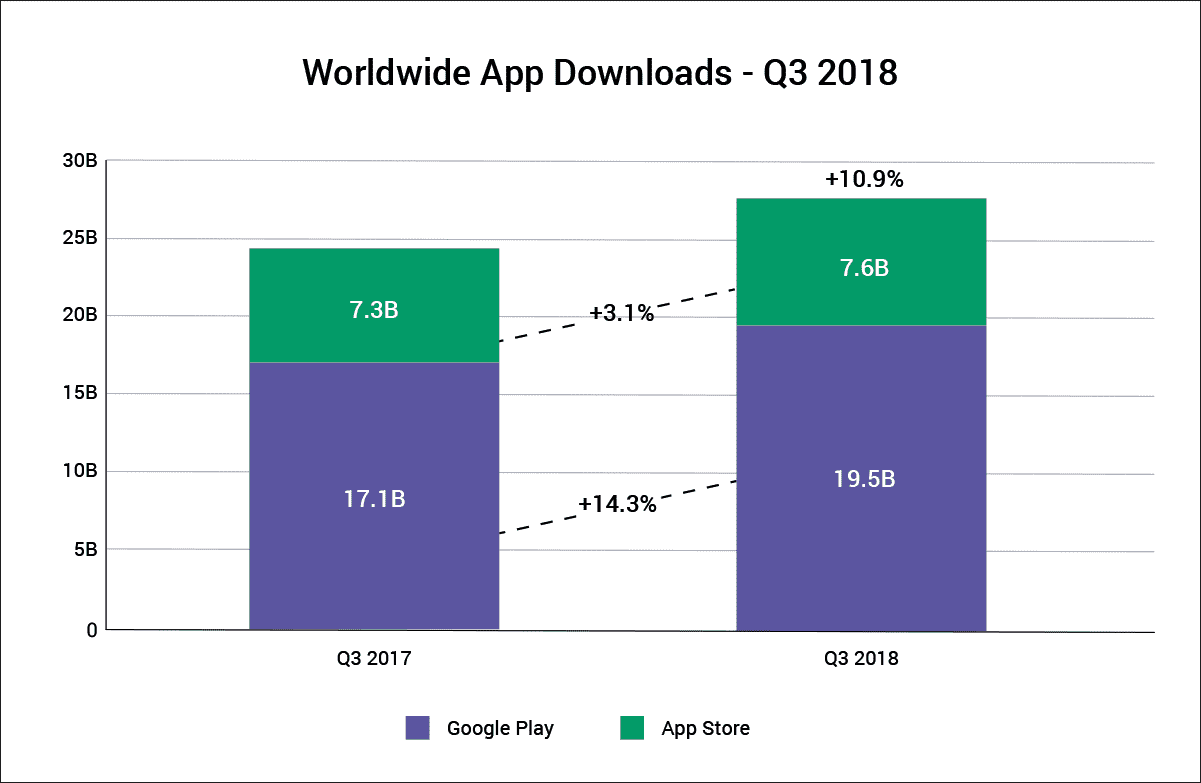
The Android operating system is popular in up-and-coming markets like Asia and Africa. Devices are low cost to create compared to iPhones. On the flipside, iPhones and other Apple products have a stronger hold, and thus popularity in North America and the U.S. Apple users are often more willing to pay for an application.
Think about the geographical location of your users. Where in the world do they fall? With that information, you can think on which operating system might be better to chase after in the beginning development phase. Of course, there are mobile app development approaches that help you to target both operating systems, and we’ll get into that.
Keep Users Engaged
Getting users to download your application is just the first step. You also want users to use the application, or they’ll just remove it to make space for the next app. Fifty-seven percent of users uninstall an application within the first month of a download, and that attrition rate only grows over time.8
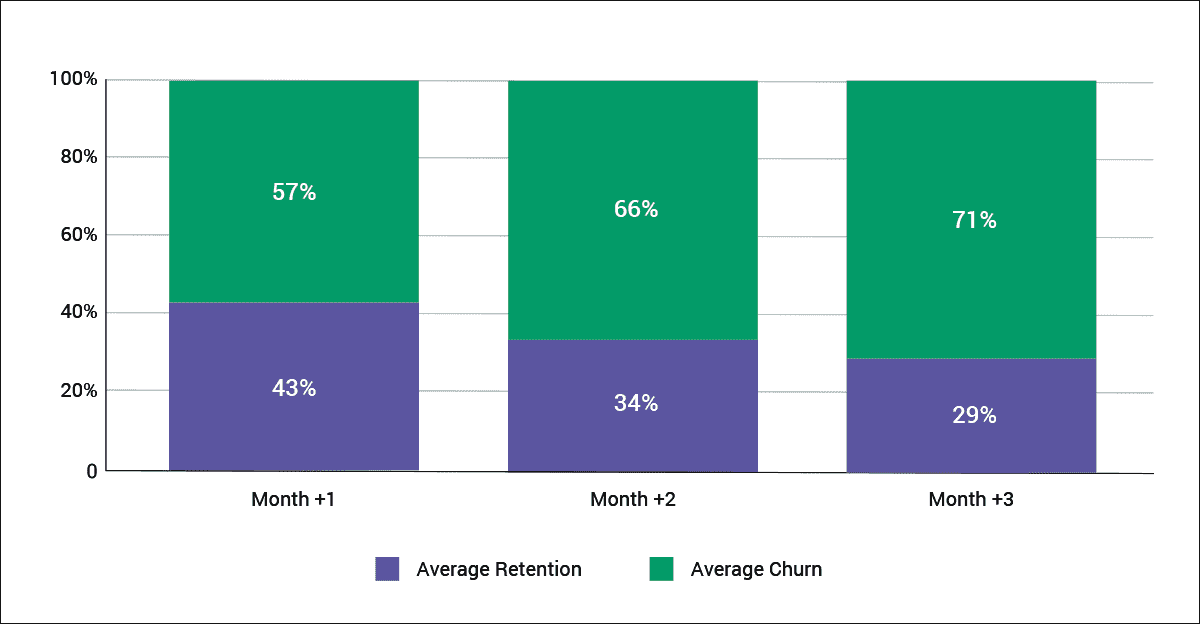
Track retention and churn rates to better understand user pain points. Be responsive to customer complaints in the application stores you make your app available in, because that information is valuable. It can shine a light on glitches and bugs that need to be repaired. Feedback can also tell you if your app is missing an important feature that users want.
Most users uninstall applications because they haven’t used them enough.9 As stated above, others remove apps that take up too much memory. The third most cited reason for uninstalling an application is that the ad sends too many advertisements, leaving users feeling spammed.
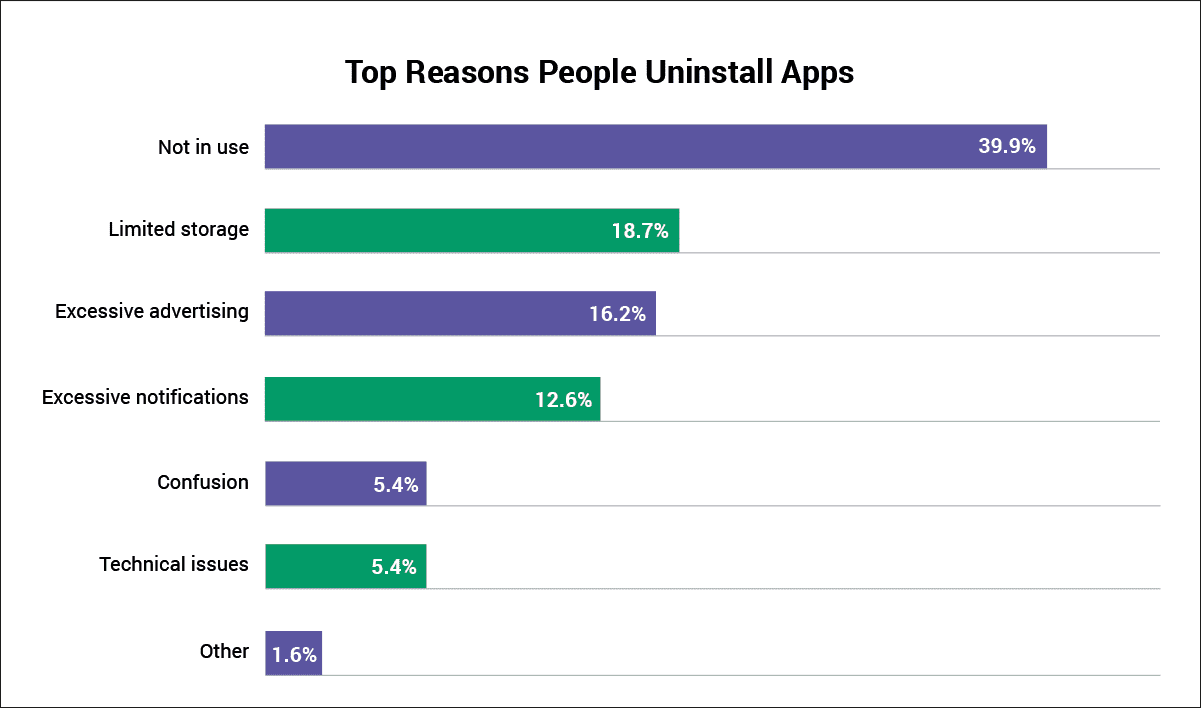
According to research, users prefer applications that use less space, load fast, and are stable.10 Of course, apps that take up a lot of memory are kept around if they’re used often enough.
With the number of apps available, though, it’s paramount to make sure your app meets users’ expectations because there are dozens of alternatives.
In today's digital age, businesses need to provide their customers with the best mobile experience possible. This begs the question: should they invest in native applications or progressive web applications (PWA)? Understanding the differences between these two types of apps is key to making an informed decision that meets your customers' needs while also benefiting your business. In this article, we will analyze the pros and cons of both native and progressive web apps, and shed light on which app type is better for you.
Key Takeaways
- Native apps and PWAs are two types of mobile applications that businesses can invest in to reach their customers.
- PWAs are web apps that offer native app-like features, such as offline access, push notifications, and home screen installation, while eliminating the need for app store downloads.
- Native apps are downloaded from app stores and installed on mobile devices, allowing for faster performance, better user experience, and access to device-specific features.
- The choice between PWA and native app development depends on a variety of factors, including performance, development and maintenance, reach and accessibility, security, discoverability, app store presence, and cost considerations.
- Understanding the differences between PWAs and native apps is crucial to making an informed decision that aligns with your business goals and your customers' needs.
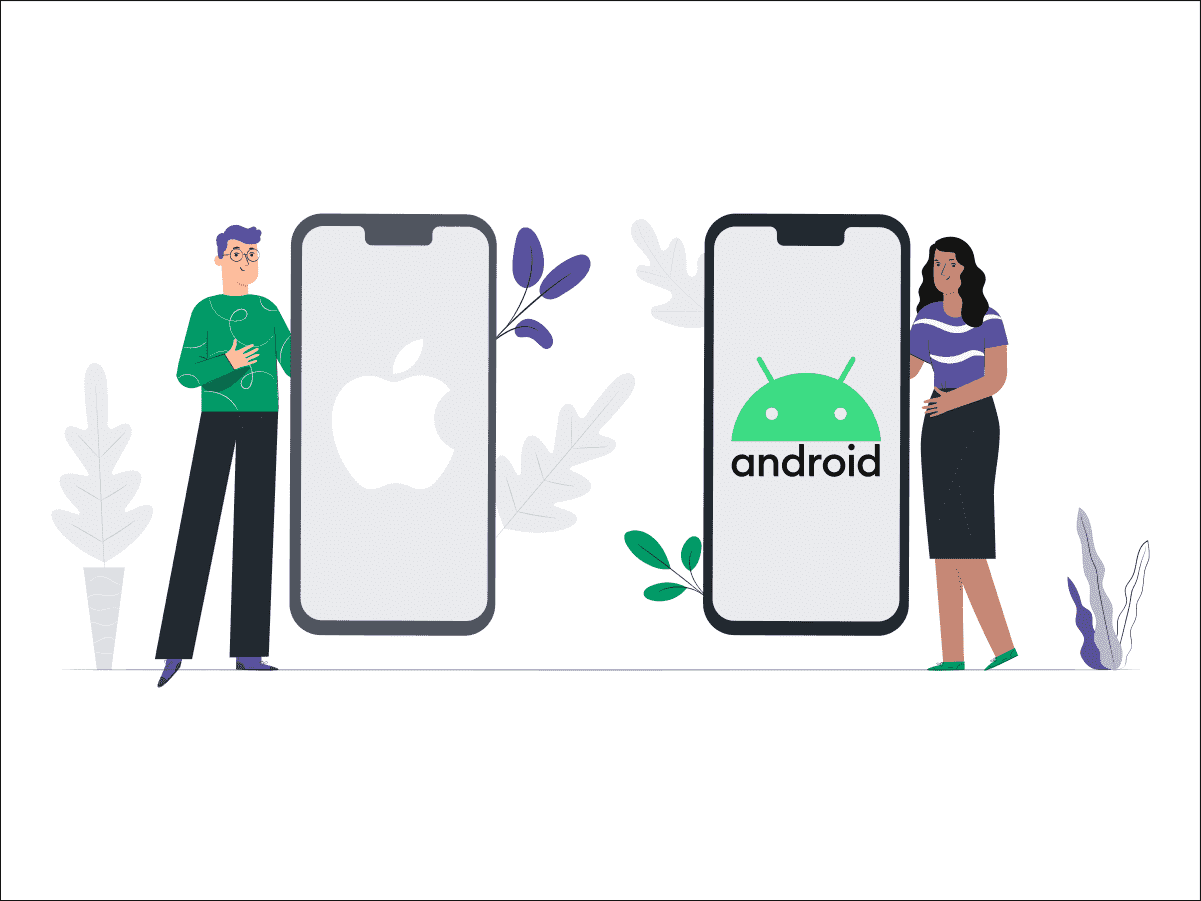
What is Native Mobile Application Development?
A native application is an executable program coded in the machine language of the hardware platform it is running in. For example, Android apps are written in Java, and iOS apps are written in Swift. For native, you need to find the app to and download it from a platform-specific application store and run directly on a mobile device.
Native app development isn’t concerned with browser compatibility or behavior; focus should be on the devices that will run the application. With native development, you can tap into features like geolocation, biometrics, and other inherent operating system functionality with an app.
Popular examples of native applications are social media sites like Facebook and Twitter, and the mobile game Pokemon Go.
Benefits
- Better performance and security: Because native apps are created specifically for the OS they work on, they’re fast and secure. A native app is ideal for performance-centric and graphic-heavy applications.
- Consistent look and feel: Native apps are created with native SDKs, which means they offer a consistent UI. This design creates a seamless experience for the user, regardless of device.
- Immediate access to new features: Because native apps interact directly with native APIs, they can access the latest OS features.
Challenges
- No flexibility: Native applications can only be written with specific code. If you want to target both iOS and Android, you’ll likely be hiring two teams of developers. The code cannot be reused between platforms.
- Expensive and lengthy development: Because native applications need specific expertise, it can be difficult to find knowledgeable developers. This means fewer workers, which can lengthen development time.
- Require frequent updates: Users will need to download new versions of an app to make sure they receive any new fixes pushed to the app store by developers.

What is Progressive Web Application Development?
A progressive web application, or PWA, is delivered through the web, using technologies like HTML, CSS, and Javascript. PWAs are intended to work on any platform that uses a standards-compliant browser.
A PWA does not need a separate download, but it does mean a user needs to be connected to the internet in order to access your application. On the other hand, it works regardless of the device it’s accessed on, whether it’s iOS or Android.
Popular examples of those who decided to build a PWA are AliExpress, Pinterest, and Uber.
Benefits
- Shorter development time: Because they work across different devices without needing different codebases, a PWA can be developed in a much shorter timeframe than a native application. This also means PWAs have lower development costs than native apps.
- Easier to maintain: Developers don’t have to rely on users to download every new update that’s pushed to an app store. When the PWA is updated, it’s updated for all users accessing it.
- Saves space on user devices: Traditional apps live on a user’s device, taking up memory. PWAs are accessed through the internet, which means they aren’t as demanding.
Challenges
- Limited access to OS: Because PWAs are essentially advanced websites, they can’t harness inherent OS features like proximity sensors, geofencing capabilities, and advanced camera features.
- No app integration: PWAs cannot access other applications, such as a user’s contact list, since the PWA does not live on the user’s device.
- Functionality dependent on OS: Some operating systems limit the functionality of PWAs. For example, iOS restricts push notifications from PWAs, unlike Android. iOS also limits PWAs’ Bluetooth capabilities.
User Experience: PWA vs Native
One of the most important factors to consider when choosing between progressive web apps (PWA) and native apps is user experience. Both PWAs and native apps offer unique advantages and limitations in this regard. But often, people use the app without knowing how it was built.
Speed: In terms of speed, PWAs are generally quicker to load compared to native apps. This is because PWAs use service workers to cache content, enabling them to function even when the user is offline. Native apps, on the other hand, require internet connectivity to operate and may take longer to load.
Offline Functionality: PWAs have the ability to function offline, providing users with a seamless experience, regardless of internet connectivity. This makes them an ideal choice for businesses that operate in areas with low network coverage. Native apps, on the other hand, require an internet connection for most of their functionality.
Integration with Device Features: Native apps offer better integration with device features, such as the camera, microphone, and GPS. This enables them to provide a more personalized experience to users. PWAs, on the other hand, have limited access to device features.
Overall, the choice between PWA and native apps depends on the specific needs of the business and its users. While PWAs offer advantages in terms of speed and offline functionality, native apps provide better integration with device features.
Development and Maintenance: PWA vs Native
When it comes to developing and maintaining apps, there are significant differences between progressive web apps (PWA) and native apps. As PWAs are web applications, they can be developed using standard web technologies such as HTML, CSS, and JavaScript, making them more accessible and cost-effective. Native apps, on the other hand, require specific development languages and tools, such as Java or Swift, and are designed for specific platforms like iOS or Android. This difference can impact the development process, as well as the resources and expertise required.
Another key difference between PWA and native app development is platform compatibility. As PWAs are designed to be platform-agnostic, they can be accessed from any device that has a web browser, without the need for specific code adaptations. In contrast, native apps require separate development for each platform and device, which can become time-consuming and costly.
When it comes to maintenance, PWAs have the advantage of being easy to update and maintain. As they are web-based applications, updates can be pushed in real-time and do not require users to download a new version of the app. This also means that PWAs are typically more secure, as any security patches can be applied immediately. Native apps, however, require users to download updates, which can lead to instances where users are running outdated versions that may contain security vulnerabilities.
Overall, while native app development has its benefits, such as greater control over the user experience and access to device features, it can be more costly and time-consuming. PWAs, on the other hand, offer a more accessible and cost-effective development option, with simpler maintenance and updates. Choosing between the two will depend on the specific needs and goals of the app, as well as the resources and expertise available to the development team.
Reach and Accessibility: PWA vs Native
When it comes to reach and accessibility, PWA and native apps have their own strengths and weaknesses.
One of the main advantages of progressive web apps is their easy accessibility. They can be accessed by users across different devices and platforms, and do not require installation from an app store. This means that they can reach a wider audience, including users who may not have access to app stores or have limited storage space on their devices.
On the other hand, once you build a native app, it has the advantage of being listed on app stores, which can increase their visibility and discoverability. App stores offer features like app reviews, ratings, and recommendations, which can help drive user acquisition. Additionally, native apps can take advantage of the features and capabilities of specific devices, such as using the camera or GPS functionality.
When choosing between PWA and native, it's important to consider the target audience and the app's purpose. If the aim is to reach a broader audience and provide easy access, then a PWA may be the better option. However, if the app is intended for a specific platform or requires specialized device features, a native app may be more suitable.
Performance and Speed: PWA vs Native
One of the key considerations when choosing between progressive web apps (PWA) and native apps is performance and speed. While both offer a range of advantages, there are distinct differences in how they operate, which can impact their ability to deliver optimal performance.
Progressive Web App Advantages:
- PWAs often load faster than native apps due to their ability to cache content and operate offline.
- Users can access PWA content more quickly through search engines, without the need to download an app.
- PWAs have a smaller footprint than native apps, resulting in faster installation times and less impact on device resources.
Native App Benefits:
- Native apps offer better performance and speed than PWAs in some instances due to their ability to access device-specific features and utilize hardware acceleration.
- Native apps are developed be optimized for a specific platform, resulting in superior performance on that platform compared to a PWA.
- Native apps can be fully customized and optimized for the best user experience, resulting in faster load times and more seamless functionality.
Overall, the performance and speed comparison between PWA and native depends on various factors such as device, network connection, and the complexity of the application. However, depending on the use case, one approach may be more advantageous than the other. It is important to weigh the benefits and limitations of each approach before making a decision.
Security: Native Apps vs PWA
Security is a critical factor for any mobile application, whether it is a progressive web app or a native app. The data privacy and security standards have become more stringent, with the growing concerns of data breaches and cyber attacks. Thus, both PWA and native apps must comply with the security guidelines to ensure that user data is protected from unauthorized access.
Progressive Web App Advantages: PWAs are secure because they run over HTTPS, which means the data sent between the server and the user's device is encrypted. Moreover, PWAs have the advantage of not storing sensitive data on the device, reducing the risk of data breaches.
Native App Benefits: Native apps have an edge over PWAs when it comes to security as they are installed directly on the device's operating system. This means that they can leverage the device's security features like fingerprint scanning, facial recognition, and hardware protection mechanisms, making it difficult for hackers to exploit vulnerabilities. Additionally, native apps can store sensitive data locally, minimizing any dependency on network connectivity.
Both PWAs and native apps require regular updates to address security vulnerabilities. It is crucial to ensure that the app's third-party libraries and plugins are up-to-date and devoid of any known security vulnerabilities.
When it comes to choosing between PWA and native apps, it is vital to understand the security requirements of the application, the type of data being processed, and the expected user base. A carefully chosen security strategy is critical to safeguarding sensitive data, protecting the brand's reputation and maintaining user trust.
Discoverability and App Store Presence: PWA vs Native
When it comes to app discovery and increasing user acquisition, having a strong presence in app stores is crucial. Native apps have the advantage of being able to be listed and downloaded directly from the app store, making them more visible to users searching for a particular type of app. However, with the growing popularity of PWAs, app store distribution is not the only way to reach a wider audience.
Progressive web apps can be easily accessed by users directly from a website or search engine result, without the need for app store approval or download. This allows for a broader reach and accessibility, especially for users not familiar with app stores or unwilling to download yet another app.
Another factor to consider is app store optimization (ASO), which involves optimizing an app's metadata to improve its visibility and ranking in app store search results. ASO can be time-consuming and costly, requiring specific knowledge and skills. PWAs, on the other hand, are indexed like websites and can benefit from search engine optimization (SEO) techniques, potentially driving more traffic to the app.
Choosing between PWAs and native apps in terms of discoverability and app store presence requires an understanding of the target audience, how they prefer to access and discover apps, and what marketing strategies are most effective in reaching them.
Cost Considerations: PWA vs Native
When it comes to choosing between progressive web apps and native apps, cost is a major consideration. The cost of development, maintenance, and potential return on investment (ROI) varies greatly between the two options.
Development costs for progressive web apps tend to be lower than those for native apps due to the ability to use common web development technologies. However, native apps may have a bigger potential for ROI due to their ability to monetize through app stores and in-app purchases.
Maintenance expenses also differ between the two options. Progressive web apps have the advantage of being updated automatically, thus reducing the need for constant maintenance. On the other hand, native apps require regular updates and maintenance, especially when dealing with multiple platforms.
When considering cost, it's important to weigh the potential benefits of each option. Native apps generally provide a better user experience and increased functionality, which can lead to higher usage and revenue. However, progressive web apps can be a more cost-effective solution for businesses looking to expand their reach on multiple platforms.
Choosing Between PWA and Native
Ultimately, the decision between progressive web apps and native apps depends on the specific needs and goals of the business or organization. If a high level of functionality and a seamless user experience are top priorities, then a native app may be the best option. However, if cost effectiveness and wider reach across platforms are priorities, then a progressive web app may be the better choice.
It's important to weigh the pros and cons of each option and consider factors such as development costs, maintenance expenses, potential ROI, and user experience. It may also be beneficial to consult with a software development company, such as Softjourn, to determine the best solution for your business needs.
Case Studies: Real-Life Examples of PWA and Native Apps
Many businesses and organizations have implemented either progressive web apps or native apps, or both, to improve their mobile strategy. Here are some real-life examples of companies that have leveraged each approach:
Progressive Web App Examples
| Company | Description | Result |
|---|---|---|
| Alibaba | Launched a PWA to improve mobile shopping experience | Increased conversions by 76% |
| Forbes | Implemented a PWA to improve content delivery and engagement | Improved load times by 100%, saw a 43% increase in sessions per user |
| Twitter Lite | Developed as a PWA to reduce data usage and improve performance for users in emerging markets | Reduced data usage by 70%, saw a 75% increase in tweets sent |
These examples demonstrate the advantages of progressive web apps, such as improved performance, reduced data usage, and increased engagement.
Native App Examples
| Company | Description | Result |
|---|---|---|
| Uber | Launched a native app to offer fast and convenient ride-hailing services | Improved user experience, with real-time tracking of drivers and in-app payments |
| Spotify | Developed a native app to deliver personalized music recommendations and a seamless listening experience | Increased user engagement and retention, with over 356 million monthly active users worldwide |
| Bank of America | Launched a native app to enable users to access banking services on-the-go | Improved customer satisfaction and loyalty, with over 31 million active mobile banking users |
These examples highlight the benefits of native apps, such as superior user experience, advanced functionality, and increased customer loyalty.
Choosing Between PWA and Native
After considering these real-life examples, and analyzing the various factors discussed in this article, it is clear that both progressive web apps and native apps have their advantages and disadvantages. Ultimately, the choice between the two will depend on the specific needs and goals of each business or organization.
For companies looking for a cost-effective and flexible option, progressive web apps may be the way to go. On the other hand, businesses seeking a superior user experience and advanced functionality may find that native apps offer the best solution.
Therefore, it is essential to carefully consider the factors outlined in this article, and consult with experts in mobile app development, in order to make the most informed decision regarding the type of mobile app that is best suited for your business or organization.
Future Trends: The Evolution of Progressive Web Apps vs Native
As technology continues to advance rapidly, the future of app development is an exciting and evolving landscape. The competition between progressive web apps and native apps is likely to intensify as both technologies improve and push the boundaries of what is possible.
The Future of Progressive Web Apps
One of the most promising aspects of progressive web apps is their potential to become even more app-like. With the advent of new technologies such as WebAssembly and Web Components, progressive web apps can start to incorporate even more advanced features, such as better offline functionality and more sophisticated UI controls.
Another trend is the growing use of machine learning and artificial intelligence in app development. This offers exciting possibilities for PWAs to become even more personalized and intelligent.
The Future of Native Apps
Native apps are also continuing to evolve, with mobile operating systems becoming more sophisticated and offering more powerful capabilities. This will allow native apps to take advantage of new features and functions, resulting in even more advanced and engaging user experiences.
As the use of augmented reality and virtual reality technologies becomes more widespread, native mobile apps are likely to benefit greatly from these innovations. For example, apps that use these technologies could become more immersive, interactive, and engaging.
The future of app development is an exciting and rapidly evolving landscape, with both progressive web apps and native apps poised to play a vital role. As technology continues to advance, developers will be able to create even more advanced and engaging apps, pushing the boundaries of what is possible and providing users with truly exceptional experiences.
Conclusion: Choosing Between Progressive Web Apps and Native Apps
After analyzing the differences, advantages, and considerations of progressive web apps and native apps, it's clear that both options have their benefits and drawbacks. Choosing between the two depends on various factors, including the specific needs of the project, target audience, available resources, and expected outcomes.
Progressive web apps excel when it comes to accessibility, reach, and cost-efficiency. They don't require an app store presence, are compatible with multiple platforms and devices, and offer a seamless user experience. However, they may lack some of the advanced features and functionalities to replace native apps provide.
On the other hand, native apps offer unparalleled performance, speed, and security. They can leverage the device's hardware and software features and provide a more personalized experience. However, they require more extensive development efforts, updates, and maintenance, and may have limited reach and accessibility.
Ultimately, the choice between progressive web apps vs native apps comes down to the specific requirements and goals of the project. In some cases, a hybrid approach that combines the best of both worlds may be the ideal solution. Companies and organizations should carefully assess their needs and resources and seek the guidance of experienced professionals for the best outcomes.
What does Softjourn Recommend?
Our Clients (and Devs!) Prefer Cross-platform
So which approach has Softjourn been recommending?
After analyzing requests we’ve worked on over the last few months, it looks like cross-platform apps are a favorite among clients. Our devs enjoy cross-platform tools as Xamarin and React Native, too.
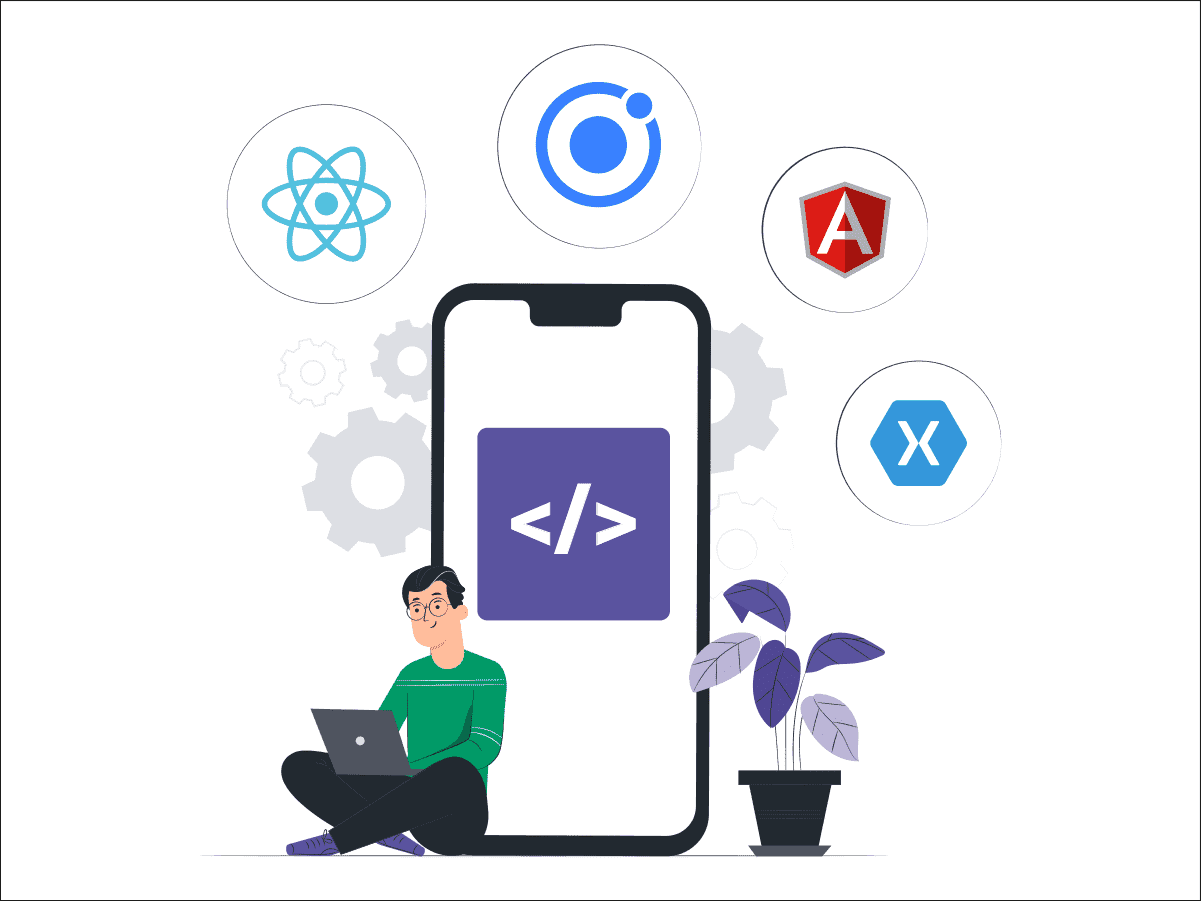
Our clients prefer a cross-platform approach because it saves development time and cost, while still giving the look, feel, and functionality of a native app.
And our tech people recommend using cross-platform technologies:
While native apps offer a great user experience, cross-platform reduces the cost and time of development. As a cross between both approaches, progressive web app development might just combine the best of all features.
Progressive Web Apps as an Alternative
Even though PWAs might lack some functionalities when compared to cross-platform and native apps, they’re still the right fit for some customers.
PWAs offer a better way to use the internet on a mobile platform, without using a native application. Think of it as a website that looks like an app and provides the same functionality. Users don’t have to install anything, but they get the same experience as if you had an actual application.
In 2017, Pinterest converted their application into a PWA in three months.11 With this transformation, they increased time spent in their app, user-generated ad revenue, and ad click throughs.
Other popular examples of PWAs are Twitter and AliExpress. Twitter rolled out its Twitter Lite in 2017, offering an alternative experience that was fast and responsive.12 AliExpress saw an 104% increase in new user conversion rates with a PWA.13
It’s clear that PWAs offer great benefits, depending on the application an organization wants to offer their audience. PWAs are an especially good fit for the ecommerce industry.
Advantages of PWA Over Native Apps
In the swiftly evolving realm of mobile and web applications, Progressive Web Apps (PWAs) have emerged as a formidable counterpart to native apps. Bridging the gap between traditional web experiences and mobile applications, PWAs offer a unique blend of web accessibility and native app-like functionality.
-
Cross-Platform Compatibility: PWAs exhibit superior compatibility as they are accessible via a browser, enabling seamless operation on any operating system or mobile device, be it a smartphone or tablet.
-
Cost Efficiency: The development of a Progressive Web App is notably cost-effective. As it essentially remains a website, the investment required is significantly lower. The inherent compatibility across various platforms necessitates only a single development cycle, managed by one development team, further reducing costs.
-
Direct URL Access: The ease of access is a hallmark of PWAs. There's no need for a download or installation; a simple browser access is all that's needed. For convenience, users can pin the PWA to their home screen for quick access. Furthermore, sharing a PWA is as straightforward as sharing a URL.
-
SEO Advantages: Operating as websites, PWAs benefit from Search Engine Optimization (SEO) for promotion, negating the need for extensive marketing campaigns. Additionally, the mobile-first indexing policy by Google augments the ranking of PWAs, enhancing their visibility.
-
Minimal Memory Usage: PWAs are not bound by downloads and hence utilize a minimal amount of memory, making them a memory-friendly choice for users with limited storage space.
-
Enhanced User Engagement: Despite being a refined version of a website, PWAs have the prowess to keep users engaged through features like push notifications, which traditionally were only associated with native apps.
-
Native App-like User Experience: The user interface and experience of a PWA are designed to mimic that of a native app, offering users a seamless, app-like interaction.
-
Automatic Updates: One of the convenient features of PWAs is their ability to update automatically. Users are spared from manual updates, as all new features are made available automatically without any required action from the user.
These aspects highlight the considerable advantages of opting for a Progressive Web App over native applications, especially in scenarios where cost-efficiency, ease of access, and SEO are paramount.
About Softjourn
Softjourn is a software development company that specializes in building progressive web apps and native apps. They have years of experience working with clients from various industries, including finance, healthcare, and transportation. Softjourn's team of experts can assist businesses in creating custom solutions that meet their specific needs, from ideation to implementation and maintenance.
With Softjourn, clients can expect a collaborative and agile development process that ensures their project's success. Their goal is to help businesses improve and innovate by creating high-quality software applications that drive revenue and enhance user experience. They strive to deliver solutions that are reliable, scalable, and cost-effective.






